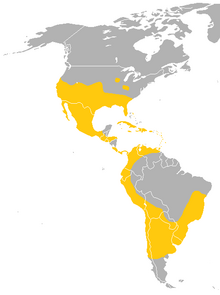Mexican free-tailed bat
The Mexican free-tailed bat (Tadarida brasiliensis) is a type of bat. It is also called the Brazilian free-tailed bat. It is native to North and South America.
| Mexican free-tailed bat Tadarida brasiliensis | |
|---|---|

| |
| Song of male, slowed eight times | |
| Scientific classification | |
| Domain: | Eukaryota |
| Kingdom: | Animalia |
| Phylum: | Chordata |
| Class: | Mammalia |
| Order: | Chiroptera |
| Family: | Molossidae |
| Genus: | Tadarida |
| Species: | T. brasiliensis
|
| Binomial name | |
| Tadarida brasiliensis (I. Geoffroy, 1824)
| |
| Subspecies | |
| |

| |
| Range of the Mexican free-tailed bat | |
Description
changeMexican free-tailed bats are usually 9 cm (3.5 in) long. They weigh around 7–12 g (0.25–0.42 oz). Females tend to be a little bit heavier than males.[2] Their ears are wide, rounded, and large compared to their heads. They use their large ears to help them find prey using echolocation. The wings are long and narrow with pointed tips. The color of their fur ranges from dark brown to gray.[2]
Distribution and Habitat
changeThe Mexican free-tailed bat is found from the southern half of the United States through most of Mexico, and through most of Central America into South America. They are also found in the Caribbean. They are native to all of the Greater Antilles and 11 of the Lesser Antilles. The largest known colony is found at Bracken Cave, north of San Antonio, Texas, with nearly 20 million bats.[2][3]
Mexican free-tailed bats mainly live in caves. They also live in buildings as long as they have access to openings and dark recesses in ceilings or walls.[2]
Mexican free-tailed bats in southeastern Nevada, southwestern Utah, western Arizona, and southeastern California come together to migrate southwest to southern California and Baja California. Bats in southeastern Utah, southwestern Colorado, western New Mexico, and eastern Arizona travel through the western edge of the Sierra Madre Oriental into Jalisco, Sinaloa, and Sonora. In the summer, some bats in Kansas, Oklahoma, eastern New Mexico, and Texas migrate southward to South Texas and Mexico.[2][4]
Feeding
changeMexican free-tailed bats are mainly insectivores. They hunt their prey using echolocation. The bats eat moths, beetles, dragonflies, flies, true bugs, wasps, and ants. They usually catch flying prey while flying.[5]
Predators
changeMexican free-tailed bats has many predators. They include red-tailed hawk, American kestrels, great horned owls, barn owls Mississippi kites, Virginia opossums, striped skunks, and raccoons. Snakes such as eastern coachwhips and eastern coral snakes may also prey on them.[6][2]
Behavior
changeMexican free-tailed bats are nocturnal animals. They begin feeding after dusk. They travel 50 km to feed. They fly at altitudes of around 3300 m. They most active in late morning and afternoon between June and September.
References
change- ↑ Barquez, R., Diaz, M., Gonzalez, E., Rodriguez, A., Incháustegui, S. & Arroyo-Cabrales, J. (2015). Tadarida brasiliensis. The IUCN Red List of Threatened Species doi:10.2305/IUCN.UK.2015-4.RLTS.T21314A22121621.en
- ↑ 2.0 2.1 2.2 2.3 2.4 2.5 Wilkins, Kenneth T. (1989-05-12). "Tadarida brasiliensis". Mammalian Species (331): 1–10. doi:10.2307/3504148. JSTOR 3504148.
- ↑ Genoways, Hugh H. (2001). Review of Antillean bats of the genus Ariteus /. Lubbock, TX: Museum of Texas Tech University. doi:10.5962/bhl.title.156678.
- ↑ Glass, Bryan P. (1982-05-21). "Seasonal Movements of Mexican Freetail Bats Tadarida brasiliensis mexicana Banded in the Great Plains". The Southwestern Naturalist. 27 (2): 127–133. doi:10.2307/3671136. JSTOR 3671136.
- ↑ McWilliams, Lisa A. (2005). "Variation in Diet of the Mexican Free-Tailed Bat (Tadarida Brasiliensis Mexicana)". Journal of Mammalogy. 86 (3): 599–605. doi:10.1644/1545-1542(2005)86[599:VIDOTM]2.0.CO;2. ISSN 0022-2372. S2CID 86220457.
- ↑ Mikula, Peter; Morelli, Federico; Lučan, Radek K.; Jones, Darryl N.; Tryjanowski, Piotr (2016). "Bats as prey of diurnal birds: a global perspective: Predation of bats by diurnal birds". Mammal Review. 46 (3): 160–174. doi:10.1111/mam.12060.[permanent dead link]
